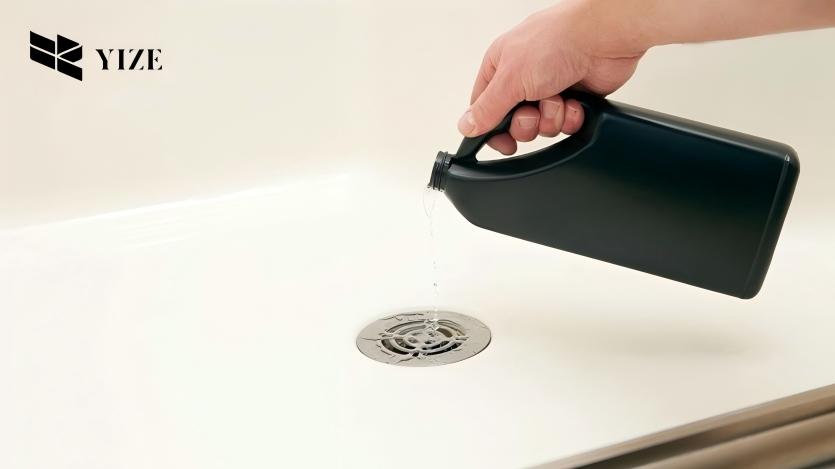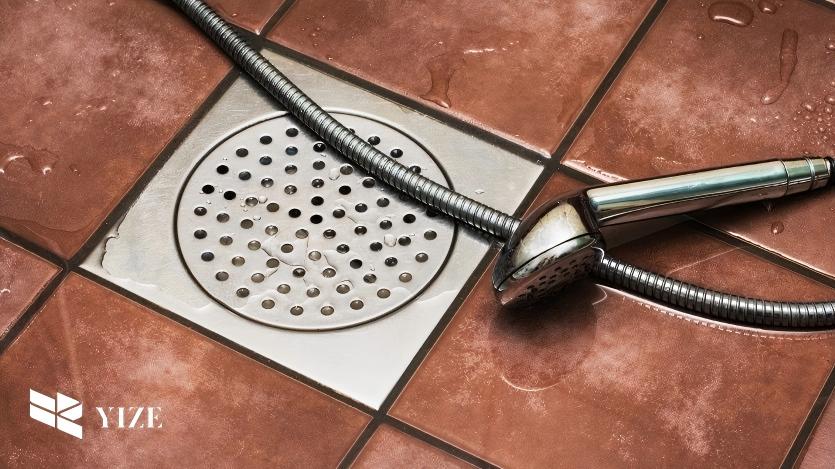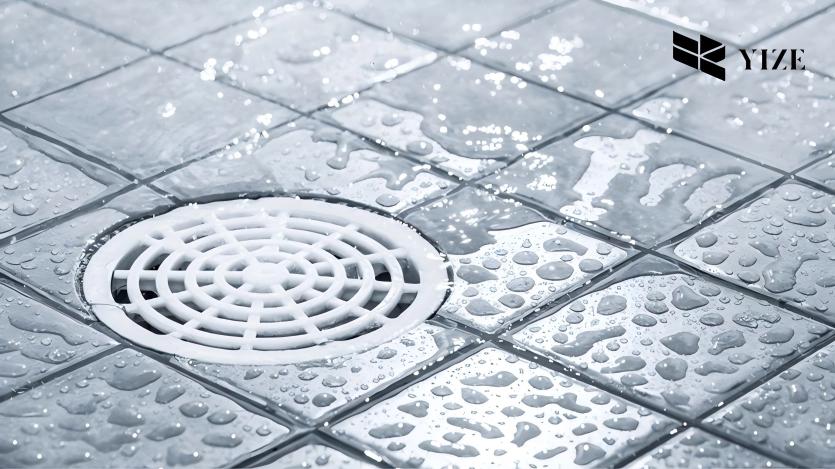
Standing in a cold shower with water pooling around your feet? A frozen drain stops everything. It feels like a big problem, but you can often fix this yourself. We’ll show you exactly how.
Here’s what we cover:
- Why drains freeze.
- Spotting the freeze.
- Simple DIY fixes.
- Keeping it from happening again.
We focus on drains day in and day out. Our experience comes from designing and manufacturingsolid drain solutions.
I. Why Your Shower Drain Freezes
Cold outside makes things cold inside. When temperatures drop below freezing, any water just sitting in your drainpipe becomes a problem. Imagine physics for a second: water expands when it freezes solid. That expansion can turn a clear pipe into an icy blockade pretty fast.
1. Contributing Factors You Can Control
It’s not only about the outside temperature, though. A few things closer to home can make your drain much more likely to freeze solid when winter hits.
(1)Where Your Pipes Sit
Take a look at where your shower plumbing runs. If those pipes are routed along an exterior wall that isn’t well insulated, they’re practically sitting outside. That lack of protection chills the pipe directly, making it super easy for water inside to freeze up.
- Pro Tip: Pipes on outside walls are always higher risk in cold climates.
(2)Drainage Speed Matters
Is your shower drain a bit sluggish? Slow drainage is a major setup for freezing. If water pools instead of running right down, that standing water is just waiting for the cold to turn it into ice. Partial clogs from soap scum or hair are common culprits for creating these little ice ponds.
- Signs of slow drainage:
- Water pooling in the shower base.
- Gurgling sounds from the drain.
- Shower takes a while to empty after you turn off the water.
2. How Drain Quality Helps
Believe it or not, the design and material of your drain system play a role in preventing freezes, too. A drain built to encourage smooth, fast flow minimizes standing water. Quality materials resist temperature changes better and prevent the minor structural issues that can cause clogs over time.
This is where good manufacturing shines. Drains made from high-grade stainless steel, like theones we build at YZDRAIN, offer reliable performance. Their design promotes efficient water movement, leaving less chance for water to linger and freeze, even when the house gets a little chilly near the drain point.
II. Spotting the Freeze

So you know why drains freeze, but how can you tell if that slow-draining or totally stopped shower is actually an ice issue? It can feel a lot like a regular clog, but there are signs that point to freezing temperatures as the culprit.
Key Signs to Look For
The most obvious sign you have a frozen drain is when zero water goes down, or it drains unbelievably slowly compared to a normal clog. Water might just sit in the shower base and not move at all.
- Look or listen for:
- Water standing completely still.
- Drainage that is much, much slower than usual.
- Feeling a distinct cold or chill right at the drain opening.
- Hearing gurgling sounds, or sometimes no sound at all, as the pipe is blocked solid.
- Seeing visible ice crystals or a solid ice block, if you can see down the pipe.
Context matters here. Are outside temperatures well below freezing? Are your shower pipes on an exterior wall? If the conditions are right and you see these signs, ice is likely the problem.
III. Simple DIY Fixes
So, you’ve confirmed you’re dealing with ice. Don’t panic; you often don’t need special tools or chemicals right away. We can tackle this with a few simple methods using things you likely already have around the house.
1. Your Go-To Home Remedies
Let’s start with the easiest stuff. These methods work best for blockages that aren’t too deep down or completely solid yet.
(1)Hot Water Power
This is the classic for a reason. Heat melts ice. But you need to do it smartly.
- Boil a pot of water.
- Let it cool slightly for a minute or two.
- Pour the hot water directly down the drain opening. Be careful not to splash yourself.
- Wait a few minutes. Can you see any change?
- Repeat the pouring process a couple more times if you see progress.
- Pro Tip: Never pour boiling hot water down a drain that is completely frozen solid, especially if you have PVC pipes. The sudden temperature shock on frozen plastic can actually cause it to crack. Start with very hot tap water or water just off the boil, and pour in stages.
(2)The Salt Trick
Salt helps lower the freezing point of water, helping to melt ice. It’s a good helper alongside hot water.
- Pour about half a cup to a full cup of table salt or Epsom salt down the drain opening.
- Follow it up with hot (but not boiling) water, as described above.
- The salt will dissolve and work on the ice blockage, especially combined with the heat. Let it sit for 20-30 minutes before trying more hot water.
(3)Gentle Heat (for accessible pipes)
If you can access the section of the pipe that’s frozen (like under the shower or in a basement), you can apply gentle heat to the frozen drain pipe outside.
- Use a hair dryer on a hot setting, aimed directly at the frozen section. Keep it moving.
- A heat gun can work, but use the lowest setting and keep it moving constantly to avoid melting or damaging the pipe material.
- Caution:Never use an open flame torch. Make sure there are no flammable materials near the pipe before applying heat.
(4)Snake It Out (Carefully)
Sometimes the blockage is a mix of ice and a regular clog, or the ice isn’t completely solid. A small plumbing snake or even a straightened wire coat hanger can help.
- Gently push the snake or wire down the drain until you hit the blockage.
- Twist and push gently to try and break up the ice or grab onto a clog.
- Be careful not to force it, as you could damage the pipe or get the snake stuck.
These home remedies are great starting points for minor freezes. But if you try these a few times and the water still isn’t draining, the freeze might be too deep or too solid for a simple DIY fix. That’s when you need to think about stepping up your approach.
IV. Keeping It From Happening Again

Let’s talk about preventing this annoying headache next winter. Putting in a little effort now can save you a lot of trouble when the temperatures drop again. Prevention really is key here.
1. Tackle the Root Causes
We know the main reasons drains freeze: pipes getting too cold and water sitting where it shouldn’t. To stop this problem for good, we target those two issues directly.
2. Prevent Cold From Reaching Pipes
Stopping the cold from chilling your pipes below freezing is half the battle.
(1)Insulate Vulnerable Pipes
Adding insulation is a smart move for any pipes that are exposed to cold air.
- Where to insulate:
- Pipes along exterior walls.
- Pipes in unheated basements, crawl spaces, or attics.
- Pipes in garages.
You can use foam pipe sleeves that are easy to slip on, or heat tape (follow instructions carefully). Even wrapping pipes with rags or blankets can offer temporary protection in a pinch.
(2)Seal Those Air Leaks
Drafts let cold air sneak in right where your pipes are. Find and seal up any gaps or cracks in walls, floors, or around pipe entry points, especially on exterior walls. A little caulk or expanding foam goes a long way here.
3. Ensure Water Flows Freely
Water that moves is much harder to freeze than water that’s standing still.
(1)Address Clogs Promptly
Don’t let blockages build up. Even small clogs slow water down and create pooling spots perfect for ice to form.
- Try gentle cleaning first:
- Pour a cup of baking soda followed by a cup of vinegar down the drain. Let it fizz for 15-20 minutes, then flush with hot water.
- Use a drain snake regularly to pull out hair and soap scum before they cause big problems.
Avoid harsh chemical drain cleaners, which can damage pipes over time.
(2)Consider Letting Water Drip
In extreme cold snaps, letting a faucet connected to vulnerable pipes drip slowly can keep water moving through the system. This makes it much harder for ice to form a solid block.
- Keep in mind: This does use water, so you’ll see a slight increase on your water bill. It’s more of an emergency measure during severe cold.
4. Choose a Quality Drain System
Sometimes, the drain itself is part of the problem. Old or poorly designed drains can have rough interiors that grab hair, shallow points where water collects, or outlets that don’t promote fast, complete drainage. This increases the risk of clogs and standing water.
A drain designed for performance helps prevent these issues from the start. Drains with smooth, polished interiors minimize snagging points for hair and soap scum. Efficient outlet designs, whetherhorizontal,vertical, orour 360° rotatable option, ensure water exits the shower base quickly and flows smoothly into the main pipe.
Usinghigh-grade stainless steel, like we do at YZDRAIN, means your drain is durable and less likely to develop imperfections over time that lead to clogs. Choosing a quality drain upfront is a long-term preventative measure.
Putting these preventative steps into action can save you from ever dealing with a frozen shower drain again.
V. Ready to Solve Drain Freezes with YZDRAIN Quality?
Dealing with a shower drain frozen standing water is a hassle, but you’ve got the power to fix it and stop it from happening again. Remember these key points from our guide.
- Cold and poor flow cause freezes.
- Look for specific signs beyond just slow drainage.
- Try hot water or salt first.
- Insulate pipes and seal air leaks.
- Keep drains clog-free year-round.
Preventing clogs and ensuring smooth flow are essential to avoiding frozen drains. That’s what YZDRAIN is built for.Our quality designs help keep your water moving freely, reducing the chance of winter headaches.
FAQs
Q1: How to unthaw a frozen shower drain?
Try pouring hot (not boiling) water down it carefully. Salt works alongside hot water, too. For accessible pipes, gentle heat from a hair dryer works.
Q2: How to melt ice in a shower drain?
Use hot tap water or water just off the boil. Pour it slowly into the drain. Repeat as needed. Salt combined with hot water helps melt ice.
Q3: What can I pour down the drain to unfreeze?
Hot tap water or slightly cooled boiled water works well. Pouring salt into the drain before the hot water helps lower the ice’s melting point.
Q4: Should I pour hot water down the drain to unfreeze pipes?
Yes, but use caution. Hot tap water or water just off the boil is fine. Never use boiling water on completely frozen PVC pipes, as it can cause cracks.
